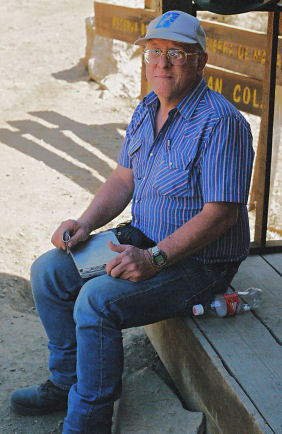
Hanging out in Mexico.
Laboratory for Environmental Biology
Centennial Museum
University of Texas at El Paso
El Paso, TX 79968-0519
Email: wmackay@utep

Hanging out in Mexico. |
William P. Mackay Laboratory for Environmental Biology Centennial Museum University of Texas at El Paso El Paso, TX 79968-0519 Email: wmackay@utep |
Dr. William Mackay is a professor in the Department of Biological Sciences and Curator of Insects. He received his Ph.D. degree from the University of California, Riverside, in 1981, majoring in Population Biology. He is a specialist on ants and termites. His interests are Desert ecology with emphasis on arthropods, especially ants and termites; biosystematics of ants, especially of the Neotropical region; ant behavioral ecology; impact of man on arid ecosystems; and biological problems involved with the disposal of nuclear waste.
Archer, S., W. Mackay, J. Mott, S. Nicholson, M. Moreno, N. Seligman, N. West, and J. Williams. 1999. Arid and semi-arid land community dynamics in a management context. In: Arid Lands Management Toward Ecological Sustainability, T. Hoekstra and M. Shachak (eds.), pp 48-74, Univ. Illinois Press, ix + 279 pp.
Mackay, W. 2000. A review of the New World ants of the subgenus Myrafant, subgenus Leptothorax (Hymenoptera: Formicidae). Sociobiology 36:265-444.
Padilla, D., N. Hogue, and W. Mackay. 2000. Preliminary results of intranidal insecticidal bait treatments on the red imported fire ant, Solenopsis invicta (Hymenoptera: Formicidae). Proc. Annual Fire Ant Conference, pages 91-96.
Gaglio, M. D., D. Padilla, W. Mackay, and N. Hogue. 2000. Effectiveness of biobarriers at preventing harvester ants from entering shallow waste containment zones: excavation of harvester ant nests located on the protective cab/biobarrier experiment site. Annual Technical Report ESRF-037: 32-35.
Mackay, W. P., A. Van Pelt, and I. Moreno. 2000. Malfunction of electrical equipment caused by Solenopsis aurea Wheeler (Hymenoptera: Formicidae). Pan Pacific Entomol. 77:126.
Mackay, W. P., C. Lopez-Castro, and F. Fernandez. 2002. A new, high altitude Colombian species of the ant genus Camponotus with dimorphic males and females (Hymenoptera: Formicidae). Sociobiology 40:421-430.
Mackay, W. P., and E. E. Mackay. 2002. Ants of New Mexico; Hymenoptera: Formicidae. The Edwin Mellen Press, Lewiston, NY, 408 pp.
Mackay, E. P., and A. Buschinger. 2002. A new species of the ant genus Leptothorax (Subgenus Myrafant) from Alberta Canada.Sociobiology 40:539-545.
Peralta, J., J. Gardea-Torresdey, J. Walton, W. Mackay, and M. Duarte. 2003. Effects of zinc upon tolerance and heavy metal uptake in alfalfa plants (Medicago sativa). Bull. Environ. Contam. Toxicol. 70:1036-1044.
Mackay, W. P. 2003. A new species of the ant genus Acanthostichus (Hymenoptera: Formicidae) from Paraguay, and a description of the female of A. brevicornis. Proc. Entomol. Soc. Wash. 106:97-101.
Fernández, F., and W. P. Mackay. 2003. The myrmicine ants of the Adelomyrmex laevigatus species complex (Hymenoptera: Formicidae). Sociobiology 41: 593-604.
Mackay, L., H. Mayland, and W. Mackay. 2003. Horse preference for alfalfa-grass hay harvested in the afternoon. Proc. Amer. Soc. Anim. Sci. 54: In press.